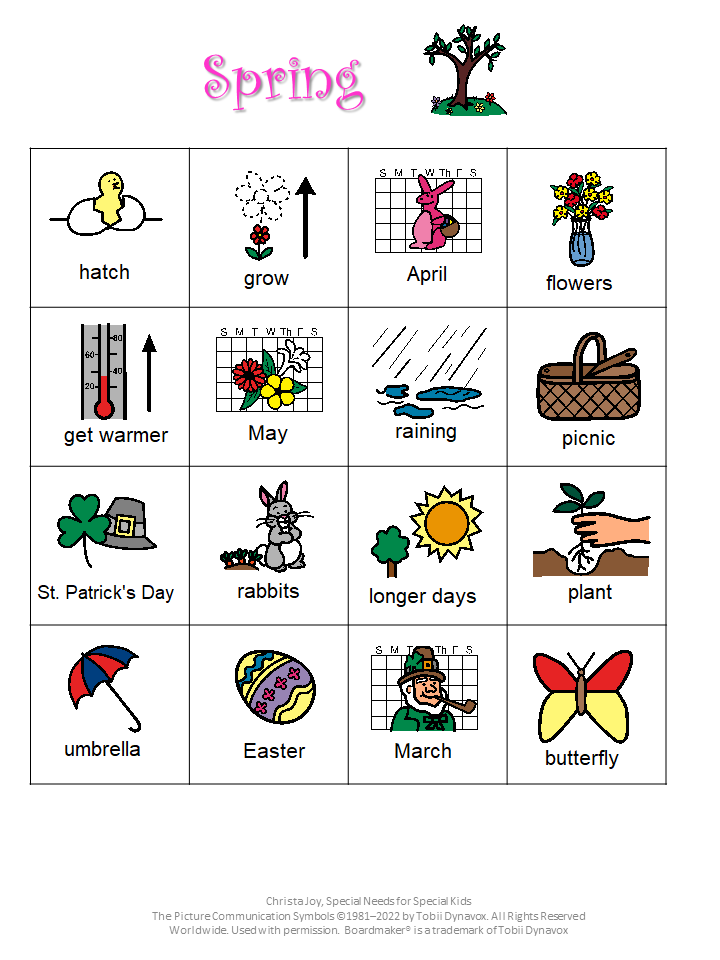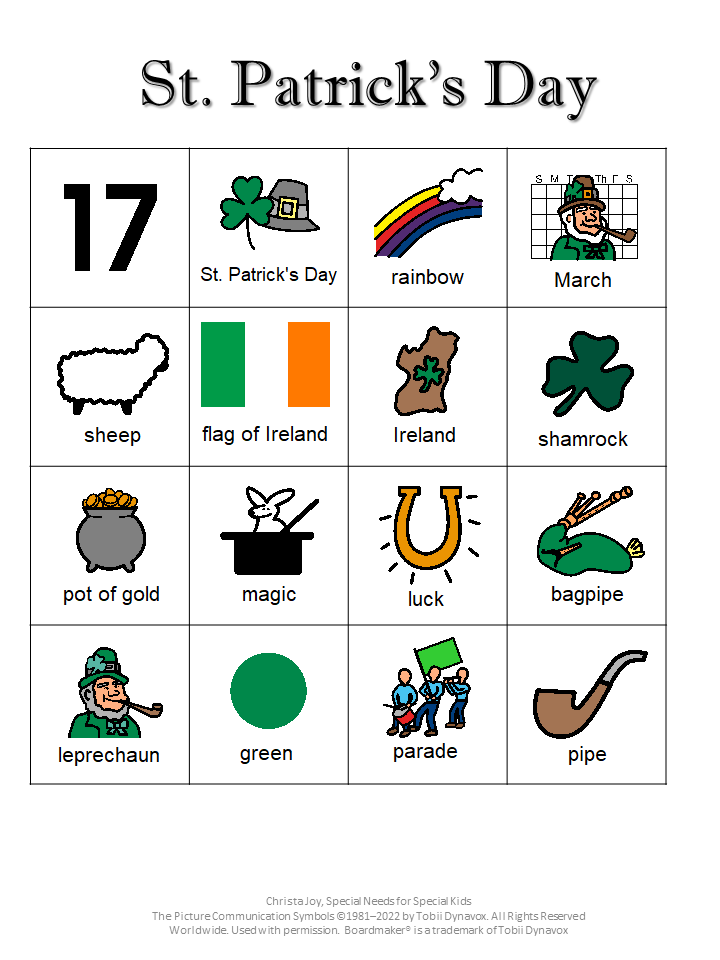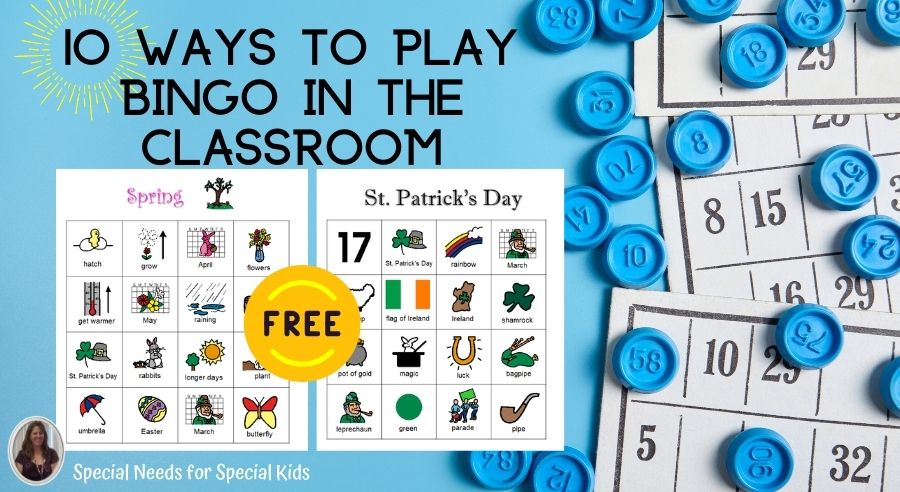Playing bingo is a great way for students to learn new vocabulary even in a special education setting. All kids love games, and this one is so easy to teach and prep. What makes it even better is there are so many ways you can utilize bingo cards in your classroom that it is worth the time, ink, and preparation to make them. Even better… you can get 2 sets of bingo cards for free at the end of this post so you can try out one or of these 10 ways to play bingo with your students.
The first 8 ways utilize the bingo card in a more traditional format. The last 2 are ways you can turn the bingo cards into something totally new.
As a bonus, I have suggestions at the end on different ways students can mark their boards to make it more engaging!!
You can CLICK HERE to download a list of ways to play bingo for easy reference.
1. Cover all
With this version of bingo, students will need to cover all the pictures on the card in order to win. In some instances, this means that all students will finish at the same time. Make sure this is clear ahead of time.
If being the winner is truly motivating for your students, then award prizes as you go. The first student to get a row complete gets a prize. Then the second student to complete a row gets a prize, etc. This will deliver intermittent reinforcement throughout the game and keep students more engaged.
2. Complete a pattern
In this version, you will determine ahead of time what the winning pattern will be. You should draw it on the board or have an example visible so students remember what the winning pattern will look like.
Here are some common patterns that are used:
- Cover all 4 corners
- Cover all the edges
- Horizontal row
- Vertical row
- Diagonal row
- Form a letter such as: L, X, E, F, T, H, I
- For a number such as: 0,1,3,4,7
- Cover every other row
- Cover every other column
Important tips:
To make this easier for students to follow, use 2 different colored counters. Use one color for the targeted squares and one color for the non-targeted squares. Again, make sure the pattern you draw or make matches the color of the markers students will be using to avoid confusion.
The other option is to have students ONLY cover the matching picture if it is in the targeted location.
3. Use the definitions
Since bingo is often used to work on vocabulary, you may opt to only give students the definition of the picture or word they are covering. Do not show them the picture, but keep it hidden from view.
You will need to decide ahead of time if you will correct students who cover the wrong one, or wait until the end and “check the answers.” This only works, however, if you have students who do not readily correct others’ mistakes.
4. The silent game
I like this version when you have students who struggle with processing verbal language. Explain to students that the entire game will be played with no talking until there is a winner, who will yell “bingo” and that includes the teacher.
Hold up each card and show it to the students without naming or commenting on it. Students will cover up the one that matches on their boards.
5. Be the detective
This version requires a little bit more skill. Similar to using the definitions, you will not show students the card. Instead, you will give clues to which picture or word you are holding. This should not be the definition, but adjectives and other facts related to the picture or word.
Decide ahead of time how many clues you will give for each card. Here are some clues you could give:
- Colors
- Relative size
- What it is used for?
- Where you would find it?
- Who would normally use it?
- Part of speech
- The sound it makes
- If it moves, how does it move?
- Is it real or pretend?
- Is it something found in the past, present, or future?
- Can you eat it or drink it?
- Would you be able to pick it up?
- Would it fit in a shoebox?
6. Work in teams
Working collaboratively is not something that always comes easily to our students. Being able to work as a team to complete their bingo board will give you the ability to target some of the social and communication goals that may be on their IEP.
This is also a great way to include buddies or regular peers who may be visiting your classroom. All kids love playing bingo, and because the rules are universally known, it makes it a good choice for a quick time filler.
7. Uncover it
This can be used with many of the other versions. Students start with the board covered with markers. You can choose to completely cover each image or word, or only partially.
If you cover them completely, you can include the added challenge of who can find the matching image first. Make sure students only remove one marker at a time, and if it is not a match, replace the marker before guessing again.
If you are trying to complete a pattern, have students replace the marker even if it is a match but in the wrong location.
8. Play as a whole group or class
Ideally, for this version, you will need to either make a larger board or have a way to project it onto the wall. As you reveal the picture or word, students will take turns coming up and marking the matching square. Using post-it notes works great for this one.
9. Make a file folder game
This is not really a way to play bingo, but a way to re-purpose your older bingo games.
- Glue down one board to the inside of a file folder.
- Laminate the file folder.
- Add small pieces of velcro to each square.
- Cut apart calling cards and laminate.
- With velcro on the backs of the calling cards, students will match identical images.
To make this more challenging, print out definitions for students to match to the pictures. This way the same file folder activity can be done by two different levels of students with very little extra work on your part.
10. Make a Go Fish game
Cutting apart 4 different bingo boards will provide you with an instant set of go-fish cards.
This is a great way to review older vocabulary and promote generalization across different environments and people while using the same stimuli.
Finally, I want to encourage you to find different and creative ways for students to mark up their bingo boards. This will greatly increase engagement and make an old game feel totally new.
Here are some different ways to mark a bingo board:
- Dry erase markers (if laminated or placed in page protector first)
- Stickers
- Post-it notes
- Things from nature: nuts, stones, small pine cones, leaves, pieces of twigs
- Novelty erasers
- Stones or gems (like from an old Mancala game)
- Poker chips
- Edibles: candy, cereal, mini-marshmallows, pretzels, raisins
- Dot markers (if printed on plain paper and not planning on reusing)
- Hole punch (if printed on plain paper and not planning on reusing)
- Chalk
- Coins
- Pom poms
- Tops from water bottles
- Math manipulatives: snap cubes, bear counters, base ten blocks
And that is it!! These 10 ways to play bingo can be quick, fun, and really effective ways to learn or review vocabulary. CLICK HERE to download an easy reference sheet
I have 2 sets you can download right here and try out some of these methods right away. Each one comes in a set of 10 colored cards and 10 black and white cards. Just click the buttons below to get one or both sets.


Just want to download a quick reference list of the games I have listed here for your own reference. CLICK HERE to download a list of ways to play bingo in your classroom.


2 Comments
I don’t see the vocabulary portion of the bingo?
With the free sets, there are no definitions provided. Vocabulary with definitions is an idea if you are using your own set of vocabulary cards or a set from one of my units. Thanks for asking.
Comments are closed.